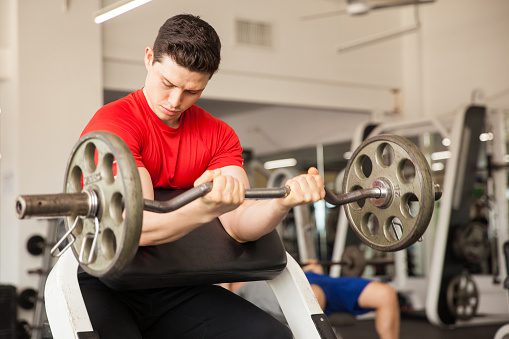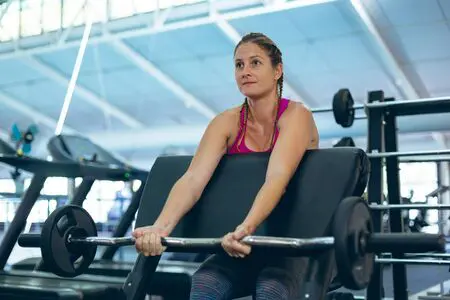
The best online fitness resource you'll ever need. We filter out the BS to ensure you meet your health and fitness goals!

The best online fitness resource you'll ever need. We filter out the BS to ensure you meet your health and fitness goals!

If you’ve been training biceps but haven’t programmed preacher curls into your workouts, you’ve been leaving gains on the table.
Whether you’re a bodybuilder; elite athlete, or weekend warrior, preacher curl is an exercise that will guarantee added performance benefits to your training goals.
Or if you’re just interested in having huge arms like Larry Scott, then this exercise is for you!
In this article, I’m going to break down my top preacher curls tips to help you make the most of this exercise and take your arm training to the next level.

A good understanding of how your biceps work is critical to maximizing your preacher curls gains.
All too often, I see biceps exercises poorly executed in the gym leaving gains on the table, workout after workout.
Your biceps main job is to flex the elbow i.e. to lift your forearm upwards and control it back downwards. Of course, it also plays a role in forearm supination and shoulder flexion.
But those roles are secondary to elbow flexion, particularly as relates to the shoulder, where the biceps role is to stabilize the anterior shoulder during shoulder flexion.
The biceps principal role is to flex the arm. The most effective of exercises to perfectly mimic this action are preacher curls. To execute this exercise correctly, the shoulder joint and upper arm are completely fixed in position leaving zero room for motion.
This means that the preacher curl perfectly isolates the biceps muscle from the bottom to the top of the range. And performing your reps with an isolated biceps throughout range ensures biceps tension and fatigue, the key drivers of muscle growth.
So in case you haven’t guessed yet, this arm exercise is an essential workout for the biceps.
You might be surprised to read, that the case for athletes incorporating this exercise into their programs is overwhelming.
When we look at common injuries to athletes in racquet or club sports e.g. tennis & golf, biceps tendon overload is a common complaint. Both golf elbow & tennis elbow describe conditions where biceps tendons are overloaded and incur inflammation as a result. Tendon injuries, while not career-threatening, are notoriously difficult to rehabilitate, and complete recovery can vary from three to six months in total.
Biceps tendon injuries can leave an athlete with unresolved, frustrating pain symptoms. Therefore programming the right exercises to prevent these injuries from occurring in the first place is the way to do it.
Preacher curls are an excellent addition to any strength program for racquet sport athletes due to the progressive and specific load experienced by the biceps during the movement, causing positive muscle-tendon adaptations to the biceps muscles.
These adaptations including size and strength are protective of the biceps, particularly strength gains (more strength = more load-bearing ability). A British Journal of Sports Medicine review demonstrated that strength training was the most effective injury reduction strategy when compared to stretching.
Therefore, to help protect against biceps tendon injuries, preacher curls, and preacher curls with dumbbells or any other variant are a welcome addition for athletes.
Other athletes that may also gain from preacher curls include throwers in cricket, baseball, or Lacrosse. Throwing actions require huge amounts of control & strength to decelerate the arm once a throw is complete, necessitating bulletproof biceps strength.

You should feel massive tension through every portion of each rep. And then towards the end, your arm will burn with fatigue.
This is what you need to make preacher curls work for you. Don’t get caught out with the errors I listed earlier. Usually, athletes cheat preacher curls by partially standing up, not working through the range, or removing their upper body from the bench.
So from a performance perspective, this is an exercise that you, as an athlete or weekend warrior have to perform.
Now bodybuilding may or may not be your thing, but the legendary bodybuilder Larry Scott, who won the inaugural Mr. Olympia in 1965, and attributed his freakish biceps size entirely to preacher curls.
Of course, a good diet, daily training, and recovery helped him along the way. But it’s worth noting that back then when bodybuilding was becoming a thing, the most successful original bodybuilders noticed that preacher curls contributed massively to their success.
So if aesthetics is what you’re training for, or you’re on the fence about hammer curls vs preacher curls, you can be sure that this arm exercise will do the job and help you achieve massive gains.

Preacher curls can be considered a vital component of any arms training program. This exercise is for everyone: athletes, bodybuilders, or anyone looking to enhance upper body aesthetics. Make sure to program preacher curls from now on, and use my top tips here to take your arms to the next level.